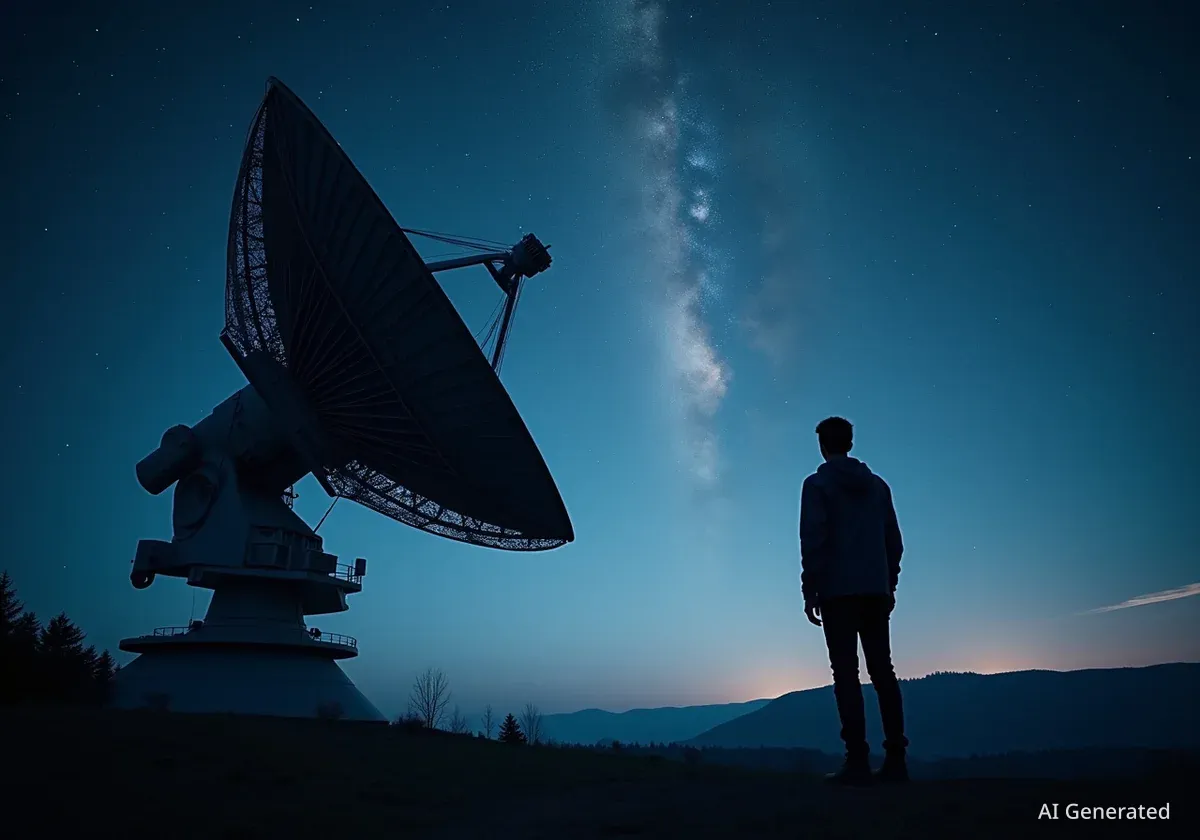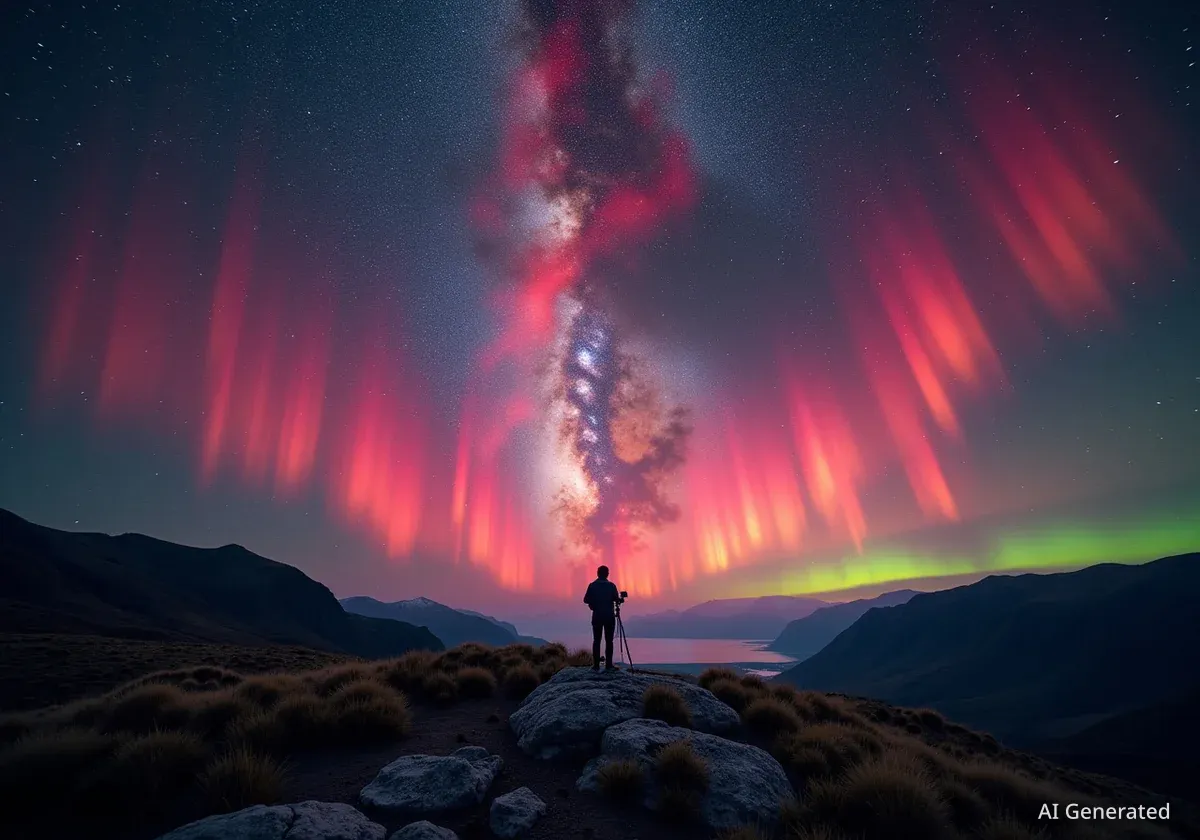Astronomers have achieved a major breakthrough by capturing the most detailed image ever of a gravitationally lensed radio arc. This record-setting observation revealed a subtle distortion, pointing to the existence of a small, unseen object approximately one million times the mass of the Sun. The discovery provides new evidence for theories about the nature of dark matter.
Key Takeaways
- Scientists captured the highest-resolution image ever of a gravitationally lensed radio arc, a phenomenon where a massive object bends light from a more distant source.
- A small kink in the arc revealed the presence of a previously undetected dark object, estimated to be around one million solar masses.
- This is the smallest such mass ever detected at these vast cosmic distances, offering a new way to study dark matter distribution.
- The finding is consistent with the prevailing 'cold dark matter' theory, which suggests dark matter can form dense clumps.
A Fortuitous Cosmic Alignment
The observation focused on a system known as JVAS B1938+666. In this system, an elliptical galaxy located 6.5 billion light-years from Earth acts as a natural lens. Its immense gravity bends and magnifies the light from another galaxy situated directly behind it, over 11 billion light-years away.
This perfect alignment creates a visual effect predicted by Einstein's theory of general relativity. When viewed in infrared wavelengths, the light from the background galaxy is stretched into an almost perfect circle called an Einstein ring. In radio wavelengths, it appears as a bright, thin arc.
Researchers believe the radio signals originate from a young, rapidly growing supermassive black hole at the center of the distant galaxy. This activity produces powerful radio emissions that are then magnified by the foreground galaxy, making them observable from Earth.
Understanding Gravitational Lensing
Gravitational lensing occurs when a massive celestial object, such as a galaxy or a black hole, warps the fabric of spacetime around it. Light from a more distant object that passes through this warped space is bent, similar to how a glass lens focuses light. This can result in magnified, distorted, or multiple images of the background source.
Unprecedented Detail Reveals a Hidden Object
To capture the image, scientists employed a technique called Very Long Baseline Interferometry (VLBI). This method connects multiple radio telescopes across vast distances, effectively creating a single virtual telescope with a size equivalent to the separation between them. For this study, 22 telescopes were linked, forming a virtual observatory the size of a continent.
This powerful array produced an image with unprecedented resolution, allowing astronomers to see fine details within the radio arc. It was in this detailed view that they noticed a small, distinct narrowing or "pinch" in the arc's structure.
"From the first high-resolution image, we immediately observed a narrowing in the gravitational arc, which is the tell-tale sign that we were onto something. Only another small clump of mass between us and the distant radio galaxy could cause this," stated John McKean, a researcher involved in the study.
This distortion indicated the gravitational influence of an additional, smaller mass. The object itself emits no detectable light in the visible, infrared, or radio spectrums, earning it the label of a "dark object." Based on the degree of distortion, the team calculated its mass to be roughly one million times that of our Sun.
What is Very Long Baseline Interferometry (VLBI)?
VLBI combines signals from multiple radio telescopes that are often thousands of kilometers apart. By synchronizing these telescopes with atomic clocks and processing the data with supercomputers, astronomers can achieve a resolution far greater than any single telescope could manage. It is like having a radio dish as large as the Earth.
Implications for Dark Matter Theory
The discovery of this small, dense object has significant implications for one of the biggest mysteries in cosmology: the nature of dark matter. Dark matter is a mysterious substance that does not interact with light but is believed to make up about 85% of the matter in the universe. A key question is whether it is distributed smoothly or if it can clump together into smaller, dense structures.
This finding supports the "cold dark matter" model, which predicts that dark matter should be able to form such clumps. The detection of a million-solar-mass object aligns with these theoretical predictions.
Devon Powell at the Max Planck Institute for Astrophysics commented on the significance of the find. "Given the sensitivity of our data, we were expecting to find at least one dark object, so our discovery is consistent with the so-called 'cold dark matter theory' on which much of our understanding of how galaxies form is based," he explained.
Complex Data Required New Methods
Analyzing the massive and intricate dataset from the 22 telescopes was a significant challenge. The research team had to innovate and develop new computational techniques to model the data accurately and isolate the subtle signature of the dark object.
"The data are so large and complex that we had to develop new numerical approaches to model them. This was not straightforward as it had never been done before," said Simona Vegetti at the Max Planck Institute for Astrophysics.
The successful analysis not only confirmed the object's presence but also paved the way for future searches. The team's work was published in two separate scientific papers, one in the Monthly Notices of The Royal Astronomical Society and the other in Nature Astronomy.
The Search for More Dark Clumps
While this discovery is a crucial step forward, it is just the beginning. Scientists now aim to use this method to find more of these small dark masses. By building a census of such objects, they can test whether their numbers and distribution match the predictions of the cold dark matter model.
"Having found one, the question now is whether we can find more and whether their number will still agree with the models," added Powell. Future observations will continue to push the limits of telescope technology to hunt for these elusive cosmic structures, potentially unlocking fundamental secrets about the universe's composition.




